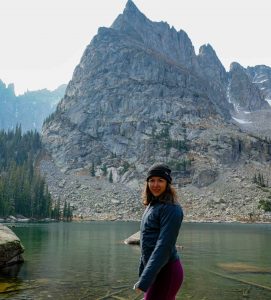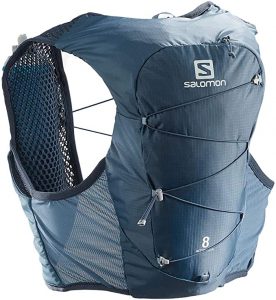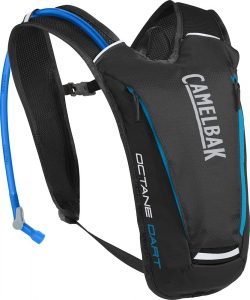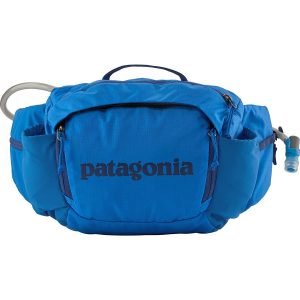Whether you’re looking to shake up your current running regimen, or you want to get into a new sport, trail running is an incredible activity that allows you to push yourself in new ways. In this article we will cover everything a beginner should know about trail running.
Quick Navigation:
Why Trail Run? | Clothing & Shoes | Hydration & Fuel | Backpacks & Vests | Accessories | Finding A Trail | Running Tips
Why Trail Run?
-
- Take your running to a new level by enjoying new terrain while also challenging your body in new ways. The unequal surfaces, varying obstacles, and ever changing surfaces work to often make trail running more physically challenging than road or treadmill running.
- Improve your hiking skills when you consistently trail run. Even with jog-running, having more time on feet in trail terrain, improving your coordination and balance, and potentially strengthening the muscles that are more hiking-specific.
- Spend more time in nature while trail running! If you’re looking at this article, it’s likely you love time outside. Getting out of your normal running loops in the neighborhood, track, or on a treadmill helps you escape from your typical mundane runs to become more connected with the outdoors. This is especially useful in today’s COVID-19 times, where many don’t feel comfortable exercising in gyms, and many gyms are either closed or have limited capacity.
Trail Running Gear & Clothing
Before you jump right into the sport of trail running, make sure you’ve got the right gear. We have pointed out below some of our favorite gear that we think will work well for anyone, however, there are tons of other options out there. We recommend at minimum you take a look at our recommendations, view the materials they are made out of and specific features they have so you can find a piece of gear or clothing that fits your needs and budget.
Shoes / Footwear
Having trail runners that are comfortable with good grip and that are lower to the ground is highly recommended. Having a good grip will allow you to run with confidence you won’t slip in various terrain and conditions (wet, muddy, sandy, etc.). If your first trail runs are going to be on well packed dirt or gravel roads, you’ll be able to utilize a normal running shoe, but when conditions get steep, wet, or muddy, you’ll definitely want a trail runner with more traction.
Features Of Trail Running Shoes
- Enhanced traction over normal running shoes for grip on mud, sand, snow, and other surfaces.
- Often times, trail running shoes will be lower to the ground, otherwise referred to as lower profile, to reduce your risk of rolling your ankle.
- Trail runners may have extra protection in case of hitting sharp rocks or roots.
- Lightweight
- You’ll find minimalist shoes that allow you to feel more of the ground, or more cushioning shoes for long distance easing of the joints. Your preference is what matters here as you’ll find supporters of both types of trail runners.
Our favorite pair of trail running shoes are the Salomon Men’s and Women’s Speedcross GTX Trail-Running Shoes (yes, we have owned several pairs and we love them!). These are extremely comfortable, resist water well, have incredible grip across a wide range of conditions (we have used these shoes through all of the seasons) and maintain a high level of foot comfort throughout the run.
Links to our favorites are below, but you simply should be looking for a lightweight, high grip, low profile shoe of your choice.
Women’s:
View Women’s Here On Amazon | View Women’s On Solomon | View Women’s On REI
Men’s:
View Men’s On REI | View Men’s Here On Amazon | View Men’s On Solomon
Clothing Layers
If you want to dive more deeply into layering, both for trail running but also just generally for your outdoor pursuits, check out our article here: https://hikingandfishing.com/winter-hiking-clothing/. Let’s dive into what layering is briefly and go over some of our top picks for tail running layers across all of the seasons.
Layering also doesn’t tend to be as important in warmer environments, so if you are beginner that is in a warmer environment, you may not need to consider your layers as much, though a base layer is often important for warm climates as well.
When selecting your gear, remember that you will produce heat while exercising, so dress for 10-20 degrees warmer than the temperature outside. This will vary on personal preference and how hot you typically get while exercising. If you’re completely new to trail running, I would opt for slightly more than you need because you can always de-layer, but you cannot add layers you don’t have!
Below, we explain some key layering for your clothing.
Base Layer
Regardless of where you live, having a base layer that is quick to dry will be critical for successful temperature acclimation in both hot and cold environments! In hot environments, you can wear your base layers alone, whereas in colder environments you should layer up. Opt for soft, light and wicking materials that are comfortable and give you the range of motion to run. Read about why a wicking material is necessary here.
When looking for a base layer, look for synthetic materials like nylon or polyester, or organic materials like wool or merino wool. Avoid materials like cotton.
Our Top Picks: Our favorite base layer top for women is the Patagonia Capilene Air Hooded Top or the Men’s Long-Sleeved Capilene Cool Lightweight Shirt and Carhartt Men’s Force Midweight Classic Thermal Base Layer top. For us, these tops are irreplaceable because they provides just enough warmth to maintain comfort on early chilly fall days, but can also be a comfortable, moveable bottom layer for colder days where you have to layer more on top.
If you prefer a short-sleeve layer (like myself), the Patagonia Women’s Capilene Cool Lightweight Shirt works wonderfully across all of the seasons. Similarly, the Men’s Airchaser Shirt is a wonderful short-sleeve option for men. We love these options, primarily for hotter days where you need something cool and light, or if you get extremely hot while exercising like myself and you need something a little cooler than a long sleeve.
Mid-Layer

Patagonia’s Thermal Airshed Jacket in Colorado
Once you have your base layer, a mid-layer can be worn to maintain heat on colder days. You should aim to have this be a looser fit with features to keep you warm while still allowing for sweat evaporation. These tops/jacket can be worn on their own or with an outer layer for more severe weather conditions. Look for nylon, polyester, or wool materials for your mid-layer.
Our Top Picks: We love the Patagonia Thermal Airshed jacket as an incredibly warm mid layer. This jacket is made with 100% recycled polyester insulation that help trap warmth, with the added bonus of having non-insulated sections under the armpits and in the back to allow for sweat wicking and just enough heat loss to prevent overheating. They make this jacket for both men and women and we couldn’t recommend it more as a great investment into more comfortable fall and winter trail running.
View Women’s Thermal Airshed Jacket | View Men’s Thermal Airshed Jacket
Outer Layer
On inclement weather days where you still want to get your trail run in, you may opt for an outer layer that will help shield you from the rain and wind. You may decide on either a wind-fighting top layer or a shell to handle heavy rain, depending on the weather you are trying to combat. The fit of this layer should be close to the body but still provide enough room for your other layers underneath, allow for full range of motion with your running, and it should be as breathable and light as possible. Make sure you are cautious about trail running in the rain or immediately after rain, especially if you are just starting out. The added wetness onto the terrain causes it to become much more slippery and increases the risk of falling or injury.
Our Favorites: We recommend you give our article on the best rain jackets for hiking a read. A newly discovered favorite that quickly moved to the top of the list when selecting outer layers for more windy conditions (and sometimes, depending on the weather, this can be used as a mid-layer) is the Men’s and Women’s Houdini Air Jacket. This jacket is an incredibly light (and I mean, INCREDIBLY light weighing in at 3.6 ounces, hence the name) to the point I always pack it in my hiking bag too since it weighs so little, but it blocks wind so incredibly well and maintains just enough heat but without overheating.
View Men’s On Patagonia | View Women’s On Patagonia
For more tough rainy conditions, we love the Columbia Women’s and Men’s Tall EvaPOURation Jacket to provide that last layer of protection. While it’s not advertised to be lightweight, the feature we love on this jacket is the armpit vent. This helps maintain the waterproof nature of the jacket while still allowing for some heat to be released.
View Women’s On Amazon | View Men’s On Amazon
We just want to point out that in conjunction with Patagonia’s new Buy Less, Demand More campaign, we here at Hiking and Fishing encourage you to purchase used as often as possible. With that, many of the items listed here may be found in the Worn Wear Patagonia clothing selection. We also encourage shopping at thrift shops, eBay, or Facebook marketplace to get as much life out of used gear as possible.
Hydration & Fuel / Food
During Your Run
This won’t be necessary for runs you know will be shorter (30 minutes or less) treks, but for your longer runs, you may want to have a source of hydration on you, and potentially a source of calories.
There are several ways you can go about this, so you should identify what works best for you. There are running vests, fanny packs, handheld water bottles with a wrist straps, lightweight backpacks, and other gear that may suit your specific needs. Keep in mind that often, trail running a certain mileage will take variable amounts of time because of different conditions, such as elevation gain differences, streams forming or water levels increasing, mud, snow, etc.
Fuel / Calories
For these longer runs you should have some fuel (such as the classic Honey Stinger Energy Gel), or another form of fast energy to maintain blood carbohydrates and replenish sodium and other minerals, especially if you are drinking water throughout.
Some Nutrition Guidelines For During Your Trail Run:
- You’ll likely want to consume around .7 grams of carbohydrates per kilogram (1.54 grams per pound) of bodyweight per hour to prevent significant declines in your blood carbohydrate levels.
- (Read more on this here: https://jissn.biomedcentral.com/articles/10.1186/1550-2783-7-7)
- Research shows that different combinations of carbohydrates, such as glucose, sucrose, maltodextrin, amylopectin, and fructose (as opposed to only one type of carbohydrate) will promote the speed at which your body can use these carbs. Ingredients of your gel or drink should tell you the types of carbs within that. (Read more on best carbohydrate combinations here: https://jissn.biomedcentral.com/articles/10.1186/1550-2783-7-7)
- You’ll likely want to consume enough calories per hour in your workout for optimal performance. To figure out the proper amount of calories, take your above number of carbohydrates, and multiply by 4. (1 gram of carbohydrates = about 4 calories)
- You’ll likely want to fuel every 20-30 minutes on runs exceeding 90 minutes. You’ll find varying advice on this from different runners. You should test out what works best for you and your body.
Disclaimer: These are simply rough estimates that can vary per individual needs, but you’ll find many trail runners fueling within these above guidelines. We recommend testing what works best for you, but also reading literature to be informed on safe and beneficial nutrition. It is recommended that you consult your doctor or medical professional on these topics.
Here are some important resources written by experts in the field if you want to look into the scientific literatures on fuel consumption during exercise (there are many more than what we have listed):
- https://jissn.biomedcentral.com/articles/10.1186/1550-2783-7-7
- https://www.scandpg.org/scan/scan-career-paths/scan-external-resources/sports-nutrition-professional-resources
- There is also a lot of research being released on fat adaptation/metabolic flexibility. To see a review of the current evidence, you may want to look at: https://physoc.onlinelibrary.wiley.com/doi/full/10.1113/JP278928
Hydration
Water is great, but many avid trail runners have electrolyte replenishment drinks. Whether it is a gatorade mix in their bottle, or some other carbohydrate and electrolyte infused drink, you may want to give this a try on longer runs. The key to choosing the right option for you is testing. Find gels and drinks that have the proper carbohydrate, electrolyte, and sugar levels, but won’t make your stomach upset. The best way to do this is to simply try some out on your training days.
Before You Run
It is also essential to be properly fueled and hydrated before your run. Not only can it be dangerous to not be ready, but you are simply going to reduce your performance if you have improper nutrition. You’ll want your carbohydrate stores topped off, and your body should be hydrated. If you are fueled properly before your run, you’ll perform better on your run. That means you can achieve better times, you may reduce your risk of injury, and your training session will be more valuable for your body.
Trail Running Vests, Backpacks, or Waist Packs
When you are trail running for long distances, in cold weather, or up mountains, it is essential to bring along some extra gear and nutrition. Runners will have different preferences, needs, and budgets, so you have plenty of options to match your preferences.
Running Vests
Running vests are extremely popular among trail runners because they are comfortable, keep the weight of hydration and food close to your body for comfort and efficiency, and are very lightweight.
Pros: Extremely lightweight and comfortable for long distances
Cons: Not nearly as much storage capacity as a backpack
Best Trail Running Vests: There are many options, so check out what suits you best here.
Backpacks
Backpacks are great options when you need to carry more gear. Especially if you are changing elevation during spring or fall when you temperatures, winds, and weather can change drastically. A small trail running and hydration backpack can be a great to hold a lot of hydration, your calories, and extra layers and gear. This is even more important if you need microspikes, ice axe, or anything like that in winter months.
Pros: More storage and more comfortable to hold heavier weight. More versatile.
Cons: When running, backpacks have more movement, often making them less comfortable than vests.
Best Trail Running Backpacks: There really are tons of options here, so check out what suits you best here.
Waist Packs
Waist packs are less popular, but some choose to go this route as they simply don’t like the vest or backpack option.
Pros: Lightweight, and simply a different style than vests or backpacks.
Cons: Usually not the most comfortable option, and usually not the easiest way to drink liquids. Less storage than other options.
Best Trail Running Waist Packs: Check out our article on best hiking waist packs.
Accessories & Other Important Gear:
- Sunscreen is extremely important for trail runners, year round. Check out our guide to choosing sunscreens.
- Headlamps for those of you who tend to prefer running in the later afternoons, early mornings or night times! On any longer run, you should be bringing a headlamp just in case.
- Having GPS watches or other systems can help you track your elevation gain, pace and distance, which will allow you to keep track of your trail running progress. They also can be used for navigation, and emergencies.
- Many trail runners will use trekking/hiking poles. Especially on runs with a lot of elevation gain and loss. This can help you power up hills, and save the knees a bit on downhills.
Find A Good Trail That Fits Your Skill Level
Another major part of trail running is realizing that this sport is not a one size fits all. There are trails that will have more difficult terrain than others, whether that be due to more hills or obstacles (weeds, rocks, scree, etc.,). There are several awesome apps that will help you to find good running trails in your area, such as Gaia GPS, Strava, RunGo, Trail Run Project and RootsRated are just a few that you can use to find good trails used by others. You can also check out our hike finder.
We also always recommend searching Facebook for local running and trail running groups. Many of these groups will be very welcoming to beginners, or those just moving to an area. This is a great way to meet experts, and potentially long term friends.
When deciding which trails to start at, you have to be realistic about your skill level and find trails that will be a challenge without being a level beyond what you would feel safe completing. Also, be prepared to slow your running pace down or opt for walking certain sections.
Local hiking trails or mountains are a great place to start. Give google a search for the area you are looking for, and you should find hiking trails with reviews, or ample information to help determine if that is a good place to go.
For your first trail running locations, you might want to find an area with the following features:
- Only a small amount of elevation gain or loss.
- Multiple routes to make your run easy to extend or shorten.
- Easy terrain. Either a gravel/dirt road, or a well maintained trail.
- Make it a trail that you are familiar with if possible.
The Run Itself
As we have mentioned several times, trail running is hard! Know that the hard work is completely normal and just a consequence of it actually being harder for your body! As with any exercise, you just need to be consistent and work at it, and trails that you felt you couldn’t complete will gradually become easier for you over time.
There are 3 main ways you can go about your trail runs.
- Walk it first. If you are unsure of what the trail will entail and you are new to trail running as a whole, I would recommend first hiking through the trail you wish to run first. Take notice of the terrain and different challenges you will encounter while running. You don’t want to be surprised with something you weren’t expecting (i.e., a river, terrain you’re not comfortable running, running into wild animals, etc.,) halfway through your run if you are not experienced. For example, I hiked through an area prior to running it and discovered it is a common area for rams to inhabit, resulting in me always staying alert and looking out on the hills for them.
- The glorious walk-jog. Depending on the trail, there may be some sections that you just cannot maintain a jogging pace on, and that’s okay! Power-hike through these sections to the best ability you can while still maintaining an elevated heart rate. When it starts to get easy, pick back up to a jog! Another way to go about this is having a more concrete routine: repeat a cycle of a 3-4 minute jog, 1-2 minute walk several times until you complete your desired run. These are great for increasing your endurance while still keeping the run enjoyable and not overly challenging. If your aerobic fitness level allows, you can up the workload to jogging intervals where you can alternate between faster paces and slow jogs in a similar fashion as described for walk-jogging.
- Jog as usual, but remember the pace will likely be slower than your normal pace for a given intensity! The varying obstacles, elevation gain, and surfaces will lead you to be out of breath at a pace that may be easy for you on roads.
Because the terrain will be different than your standard road or treadmill run, there are additional running techniques that are recommended you use during your trail runs. Here are some brief, general tips for better running form on the trails:
- On the trail, shorten your stride to keep your feet under you for better balance. This is especially the case up steep terrain. Tendencies can lead you to longer strides, but it is often more efficient to pick up your step cadence, and shorten those strides.
- Look out 10-15 feet ahead of you and pick out a safe path for each step. Make sure to place your feet on stable surfaces with every step. When trail running on difficult terrain, you want to maintain your focus.
- Make sure to keep your feet high throughout the run to avoid tripping on roots, rocks and any other hurdles.
- When you encounter a hill, shorten your stride even more and increase the frequency of your step. Also, keep your back straight, avoiding the forward lean you may be tempted to do, in order to maintain optimal breathing techniques. Also try to avoid a backwards lean when running downhill.
Trail Running Etiquette
My last tips for you who desire to get into trail running are regarding common courtesy on the trails. Identify the rules of the trail and follow them, leave no trace (i.e., take your empty gel packs or anything else you bring with you), and maybe go as far as smile at those who are passing you! Speaking of which, when you want to pass an individual, saying something such as “on your left” or asking “Can I get past you?”, depending on how much breath you want to expend, will prevent any unwanted collisions or bottlenecks with other runners or hikers.
In addition, I encourage you all to stay alert at all times regardless of the trail. You have to share the trail with runners, bicyclists and other recreational outdoor activity users (often), and wild animals. Keep at least one ear headphone-less so that you’re listening to your surroundings at all times. Whether for safety or to allow other individuals to pass you, it is the right thing to do.

Victoria Bandera has a Master’s degree in Health and Exercise Science from Colorado State University and is an ACSM certified Exercise Physiologist. Currently, Vicky is at the University of Utah working on her PhD in Population Health Sciences and working in the Huntsman Cancer Institute. She is passionate about the use of physical activity and nutrition as a source of longevity and overall health. Find her on some adventures with small health-related posts at @viqeeinthewoods on Instagram!



